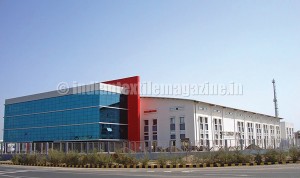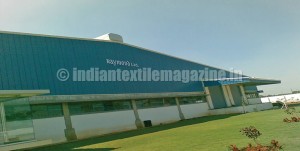Mr. Chirag Patel, Managing Director of Phenix Construction Technologies, shares his expert views on what makes pre-engineered construction technology ‘the industrial game changer’ in India and how the company technology cuts project execution time by 50 per cent.

Leading the ‘tech’ revolution in construction solutions in India is the Gujarat-based Phenix Construction Technologies, a pre-engineered construction solutions provider, which was set up in 2006 by the M&B Group, with the core business area of M&B in the initial years being to execute government irrigation projects like canals, dams, etc.
In 1993, the M&B Group set up two plants for supply of concrete sleepers to the Western Railway. Subsequent to this, the group set up two plants for manufacturing pre-stressed concrete electric poles for the Gujarat Electricity Board.
In 2001, the group diversified further by pioneering and introducing its self-supporting roofing systems technology in India under the brand name Proflex, which currently has in hand multiple projects for self-supporting roofing systems.
In an exclusive interaction, Mr. Chirag Patel, Managing Director of Phenix, talks about the Phenix philosophy and the pre-engineered construction revolution in India pioneered by the group which was started with technical know-how from Varco Pruden Buildings of the US which, at that time, was the second largest pre-engineered building company in the world.
Phenix, with a current capacity of 72,000 metric tons per annum, apart from offering pre-engineered construction solutions, has been providing structural steel solutions to heavy duty constructions like power plants, bridge girders, refineries, petrochemical structures, etc., since 2011.
The pre-engineered construction concept began around 90 years ago in the US. The 110-storey Empire State Building in New York, built in 1929, was entirely built with pre-engineered construction solutions in a record time of 18 months, with the concept at that time restricted to only residential buildings and got extended to industrial buildings in the 1950s.
Elaborating on the salient features of a pre-engineered building (PEB), Mr. Patel says: “The benefit of a pre-engineered building is that one gets a factory-made product, which comes as a kit and is assembled in to a structure at the site. The biggest advantage of a PEB is the time frame in setting it up. It takes just six months to complete the building with pre-engineered components as against around 12-15 months for a similar building constructed with brick and mortar.”
According to him, one can have a tight control over the project cost in case of pre-engineered fabrication structures as one is shielded against price escalations since the price is fixed at the time of placing the order. In the case of traditional construction, the cost of the structure may go up if the prices of cement, steel, labour, etc., go up during construction.
The other main advantage of using pre-engineered structures is the feasibility of shifting an entire building, if needed in the future. A few years back, Tata Motors shifted its already set-up industrial buildings, around 35 in number, in West Bengal to manufacture the Nano car to Sanand in Gujarat, and the production commenced at the new site in less than 15 months.
The pressing labour shortage is going to pose a concern in the coming days for the construction sector. “Pre-engineered technologies will be the answer to overcoming the shortage of labour,” says Mr. Patel who adds, “currently 60-70 per cent of industrial buildings are being put up with pre-engineered technologies in India.”
Pre-engineered structures, as compared to brick and mortar structures, add about one-two per cent to the overall project cost. However, this should not deter industries from exploring the advantages and long-term prospects of pre-engineered fabrications.
Mr. Patel discloses: “Any industrial set-up intending to go in for pre-engineered fabrications should look at the overall value accrued as production can start 50 per cent faster because construction can be done in half the time as compared to the brick and mortar structures, and the pre-engineered construction technology from Phenix cuts project execution time by 50 per cent.”
Pre-engineered buildings are designed to be earthquake and wind proof. Before designing the building, architects take into consideration the seismic zone of the place where a project is being set up as well as the wind speed. The building is designed in such a way as to be able to withstand both the natural forces.
The largest project
The largest pre-fabricated structural project executed by Phenix is the terry towels project of the Trident Group at Budhni in Madhya Pradesh in 2013. A single building structure with an area of 136,000 sq. metres, this facility was readied in just seven months with commercial production beginning within a year of the conception of the project. Mr. Patel informs that the Trident Group is now opting for this technology for all of its expansion projects.
On how the Phenix think-tank operates, Mr. Patel elaborates: “Phenix receives the basic requirements like the size of the building, skylights and ventilations needed, utilities, ducting, loading and unloading areas. Based on the inputs of the client, Phenix designs the building and comes up with a cost estimate. Once the order is placed, Phenix begins fabricating the components of the structure.”
Phenix cannot stock the components that go into the pre-engineered structure. Each structure is unique, and components like columns, pillions, girders, etc., are prepared as per the drawings and specifications of the structure and is also a one-stop solution for constructing a structure, as a client need not retain several people for designing or constructing the structure.
The major projects executed
Some of the major projects executed by Phenix for the textile industry include Trident Industries in Budhni, Arvind Mills in Santej, Raymond in Gauribidanur, Ashapura Garments in Mundra, Vardhman Group, also in Budhni, Terram Geosynthetics in Mundra, and many more.
Mr. Patel is of the view that now even upcoming medium and small-scale projects in the textile industry will follow in the footsteps of the large textile groups in India, who have set up their projects using pre-engineered structures, mainly because of the multiple benefits associated with the technology.
Pre-engineered components are made from high tensile steel. Compared to steel used in traditional construction which use E 250 grade of steel, pre-engineered components use E 350 grade of steel which has higher tensile strength.
These components include; columns, rafters and other built up sections and the wall sheeting is also made from steel and is coated with pre-coated galvalume sheet, which offers anti-corrosive properties and thereby increases the life of the walls.
A global footprint in providing cutting edge construction solutions has enabled Phenix carve a niche for itself in the industry. Apart from being a trailblazer in pre-engineered construction solutions in various industry segments in India, Phenix has successfully executed projects in East African countries like Tanzania, Uganda, Mozambique and Congo, major markets for Phenix.
The Phenix global advantage comprises the company’s endeavors in being involved in a large shipyard project in Brazil, apart from setting new benchmarks while undertaking international projects in Nigeria, Ethiopia, Qatar and many other countries.
Proflex, which is also into self-supporting roofing systems, is being adopted by industrial buildings. It is a well-developed product, first introduced in the Western markets for a specific purpose to avoid melting snow water piled on the roofs, from percolating inside the plant and over the years has been designed to perfection.
The same technology is also found very useful in India, as the country experiences heavy rainfall for three months accompanied by high velocity winds. The Proflex roofing solution, owing to its curved design, does not allow rainwater to seep into the plant, and alongside there is no damage to the roofs even from high velocity winds.
According to Mr. Patel, the impact of the ground-breaking ‘Make-in-India’ initiative of the Government will be realised from 2016 onwards. In order to meet with the potential increase in industry demand and to get closer to its customers, Phenix has plans to set up a new plant in southern India.


